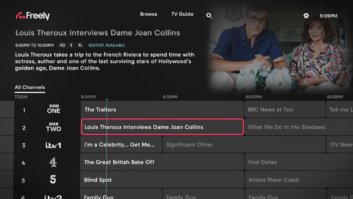There can be no argument about the fact that OTT streaming has fundamentally changed if not revolutionised, television broadcasting. This is not only in the way programming is distributed and delivered but also how and where people watch the videos. Viewing is no longer restricted to the traditional TV set in the front room or bedroom; today smartphones and other mobile devices make it possible to watch favourite films and shows anywhere at any time.

The almost seismic shift that OTT has brought about in the broadcast market extends to the playout centres that pump out all the content now available. These facilities had already been dealing with substantially more channels thanks to the move from analogue to digital transmission, but streaming has led to a massive proliferation in video services, both from linear broadcasters as well as the new breed of streamers. This has called for a new approach to monitoring ‘broadcast’ output. The dilemma is that it would be financially unviable to have an operator for each channel and expecting a small number of operators to cope with a multitude of outputs is impractical, if not physically impossible.
Which is where the multiviewer comes in. Already an established piece of equipment in broadcast production and playout, the explosion in streamed channels over the last ten years has seen this key but sometimes overlooked piece of equipment truly come into its own. In pure monetary terms, the revenue value of the Multi-Viewer Monitoring System Market was estimated at $1.11313 billion in 2021, according to a report published in October by The Insight Partners.
The report predicts the sector will hit $1.55414 billion by 2028, which underlines the necessity for multiviewers in the TV and streaming markets. The survey further concludes that this increase will be driven by the growth of the global broadcasting industry, as more channels and services are introduced around the world to meet what appears to be an almost insatiable appetite for content.
This expansion is centred on OTT in particular, which is now investing in the development and licensing of content as well as being platforms for people to watch films and episodic TV. This puts streaming services even more directly into competition with linear TV and the adoption of what the report describes as “innovative technology” will play an important role in giving companies an edge over their rivals.
This has already happened when it comes to delivery formats, with the leading streaming providers, notably Netflix, Amazon and Disney+, offering their programs and films in 4K/Ultra-HD (UHD) and HDR (high dynamic range) with Dolby Atmos immersive audio. To accommodate this, more multiviewers are now hybrid devices, able to handle both HDR and SDR (standard dynamic range) along with UHD plus SDI, uncompressed IP SMPTE ST 2022-6/2110 and compressed MPEG2, H.264, 1080p, HEVC, J2K, JPEG-XS, HLG, PQ and SLOG3, with the capability to easily switch to the required monitor format.
Software-based multiviewers are a relatively recent variation on the established hardware-based form of monitoring and Mediaproxy moved into this field with its Monwall system. We were already well-known for the Logserver compliance monitoring, logging and analysis platform and expanding into the display side of master control room (MCR) operations was a natural progression.
Unlike traditional multiviewers, which convert multiple sources into a single output, Monwall is able to decode each signal – in whatever format – on the client independently. Monwall is also independent, interactive and user configurable. Most important of all, it can monitor by exception, which means an output is only displayed when a problem is detected. This allows operators to get on with other tasks in the MCR and does not tie them to constantly looking at monitor screens.
This is particularly necessary in today’s multi-channel TV/streaming market, where we see our customers monitoring hundreds of channels at network operations centres (NOC) staffed by a small number of operators. By using Monwall’s monitoring by exception feature, the panels remain green and only turn red when an alarm is raised.
For the future, and this may be more short-term rather than long-term, we foresee artificial intelligence (AI) and machine learning (ML) applications being used with Monwall, as well as other multiviewers. It will be possible to train the AI/ML-based systems to recognise common faults and take appropriate action, introducing more reliable automation into MCR and NOC operations.
Monitoring may not be the most exciting part of broadcasting or streaming but it is absolutely vital in ensuring reliable services with good quality video and audio. Multiviewers are now key to this and will continue to develop to ensure the best video experience for the discerning viewing audience.







